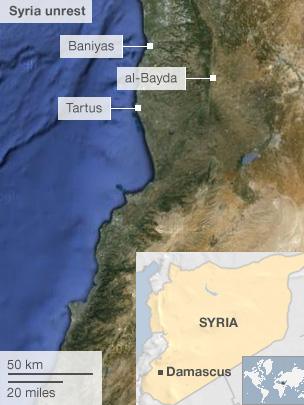Syrian activists document al-Bayda and Baniyas 'massacre'
- Published
Unverified footage, apparently filmed by pro-government fighters, shows houses and cars on fire
Opposition activists in Syria say they have documented the deaths of more than 200 men, women and children in what they say is one of the worst massacres of the war.
Earlier this month the government said it had killed "terrorist fighters" in an operation in three neighbouring districts in al-Bayda and Baniyas in the west of the country.
But graphic video footage and fresh eyewitness testimony appear to support claims that the area was witness to one of the worst atrocities of the conflict.
"No matter how I describe what we heard and what we've seen, it would be nothing like the real thing."
Clothed in a black shroud, Om Abed did not want to use her real name. She is afraid of reprisals.
'Blood everywhere'
The mother of two wept as she talked about what she says she saw in al-Bayda in early May.
"You could not walk without stepping over bodies, either slaughtered or burnt," she said. "Blood was everywhere."
On 2 May, government troops and militias marched into al-Bayda, in Tartous province on Syria's Mediterranean coast. The following day they attacked neighbouring Baniyas.

Together government forces have described these operations as a "strike against armed terrorists".
State media reported that 40 opposition fighters were killed. But Syrian human rights activists and eyewitnesses claim that more than 200 civilians died and hundreds are missing in what they allege was a brutal sectarian attack against innocent civilians.
Military assault
Video footage and photographs show the smouldering remains of burnt corpses, the bloodied bodies of men, women and young children with terrible injuries.
It is impossible to independently verify these images, but interviews conducted by the BBC with four women who say they were there at the time appear to back claims that the area was witness to a horrific massacre.
They all describe a military assault on the village that began on the morning of 2 May.
What provoked it is disputed but both sides seem to agree that government troops had been ambushed by rebel fighters earlier that day, although tensions in the area had been simmering since the uprising began.
Families huddled together as regular troops, backed by the paramilitary National Defence Force (NDF), entered the village. Residents say they embarked on a murderous attack: burning, looting and killing.
"They started insulting us, uttering dirty words," says Om Abed. "They told us to send the men out of the house, or we would all be shot."
What appears to be a leaked video taken by a government soldier gives a sense of what happened next. Troops can be seen in al-Bayda square; houses and cars are on fire, puddles of blood are visible on the road.
Then the camera moves along a path past a man prostrate on his back, dead. There is a large red smear under the back of his head marking where he had been dragged.
The film ends in what appears to be a shop. The floor is full of bodies, arranged in neat rows.
'Wild screams'
"Suddenly, we started smelling fire, we heard the wild screams of men all over the village," says Om Abed.
It was not until six that night that the women left their homes.
One of her friends, Om Ahmed, described the horrors that greeted her when they emerged.
"I ran down the road and saw 20 to 30 men, lying on the ground, all shot up. Then I saw my husband and my father-in-law. They were shot in the head.
"There was nothing left of my husband's face apart from his mouth and nose."
Activists and residents say the troops then moved on to two Sunni districts in neighbouring Baniyas.
State media said 40 terrorists were killed over the three-day operation but eyewitnesses talk of a frenzied sectarian assault by Alawite militias against the local Sunni population.
Charred bodies
Numerous pictures and videos that appear to show the aftermath of Baniyas are horrific; men, women and children, some terribly disfigured, piled together, and what appear to be entire families killed.
The women we interviewed described similar scenes. "There were slaughtered corpses and charred bodies everywhere", says Om Abed.

Om Abed told the BBC that "blood was everywhere" in al-Bayda
"Houses were on fire. The people inside them were burning. An entire family lay down dead, slaughtered in one house. There was so much blood."
This was not the first massacre of this war and it won't be the last. Some in the international community have placed their faith in diplomacy, pushing for a peace conference next month.
Few appear convinced about its chances of success and as long as both sides in this conflict continue to believe they can win, the people of Syria will continue to die.